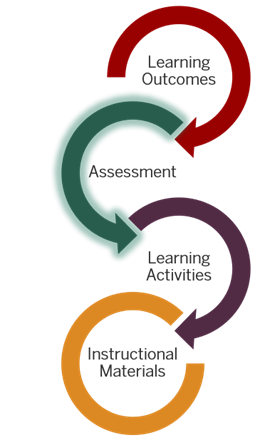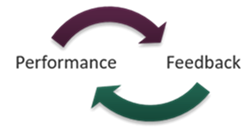Part 2: Starting with a Clear Plan
Assessments: Waypoints on the Road Map

A waypoint is a point or place on a map where you stop and can take stock of where your are to either go forward or change course. Assignments are waypoints in your course. They’re where you pause to see how your students are doing and whether you can forge ahead or if you need to circle back to something that they’re not quite understanding.
For you to tell how close your students are to your desired learning outcomes – their destination – your assignments need to give you valid evidence of their progress. Just like in a research study, where you want to make sure that your research instrument is measuring what you want it to measure, aligning your assessments to your learning outcomes makes sure you are assessing what you want to assess.
The most effective way to ensure that students get the feedback they need to stay on track is through an assessment plan that includes both formative and summative assessments.
Formative assessment
There are two main purposes of formative assessment
- to help students see what they know and don’t know and to fill in the gaps in their understanding, and
- to help instructors see both individual gaps and patterns of misunderstanding across the course to provide timely support.
It’s assessment for learning instead of assessment of learning

In an online course, it’s especially important for students to get frequent feedback on how they’re doing and formative assessment can fill that need. Examples of basic formative assessments include classroom assessment techniques (CATs) such as muddiest point or one-sentence summary activities.
Online courses lend themselves nicely to the use of automatically-graded “knowledge checks.” After completing one, students can quickly receive feedback based on the answers they chose in a multiple-choice section or compare their answers to those of an expert in a short essay section. If you are interested in more information about setting up these types of assessments, see the Canvas Guide on the different types of questions available in the Quizzing Tool and information on Quick Check.
Another option for formative assessment is to break a larger, summative assessment into smaller pieces that can be turned in throughout the semester. This allows you to catch and address misconceptions, challenge students’ early analyses, and provide the opportunity for them to revise and resubmit the individual pieces as a unified whole at the end of the semester or unit.
An often overlooked option for formative assessment is peer review and feedback. When adequately scaffolded, peer review and critique can be a learning activity for both the student giving and the student receiving the peer review. The Assignments tool in Canvas provides options for blind peer review, or you can set up a small group discussion where students post their thoughts, explanations, or examples and then provide feedback to the person posting immediately above them.
Summative assessment
In contrast to formative assessment, summative assessment is designed to provide evidence of how well students have achieved a learning outcome or otherwise gained skills or knowledge throughout the course.
It is the assessment of learning, in contrast with the assessment for learning provided by formative assessment.
Although the assessment methods that often first come to mind are tests, papers, or lab exercises, many other activities can be used for assessment, including portfolios, discussion forums, concept maps, diagrams, and presentations. You can also use assessment methods in a variety of different ways. For example, multiple-choice test items can be developed to draw attention to contextual factors in an authentic case. In the same way, artificial and minimally contextualized cases can be used to identify who, what, when, and where without asking students to work with holistic, complex problems. Click on the headings below to see more about different types of assessments.
While it’s easy to incorporate media into Assessments and Discussions, you need to keep in mind that not all online students will have the ability to easily create and upload media. Planning ahead with an alternate activity for students with technology and internet access limitations will make it much easier when the need arises. For more information about media-based assignments, see Video Assignments in Canvas in the Canvas Semester Checklist Pressbook.

